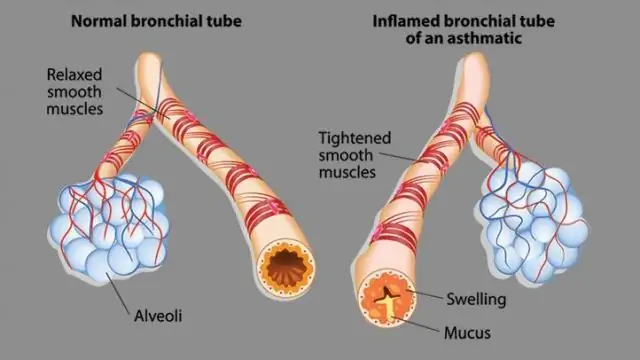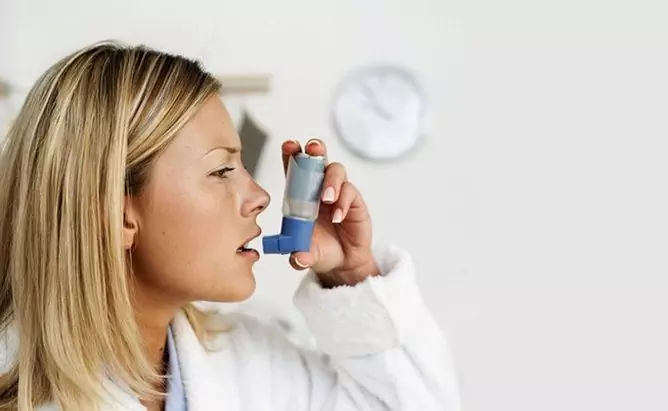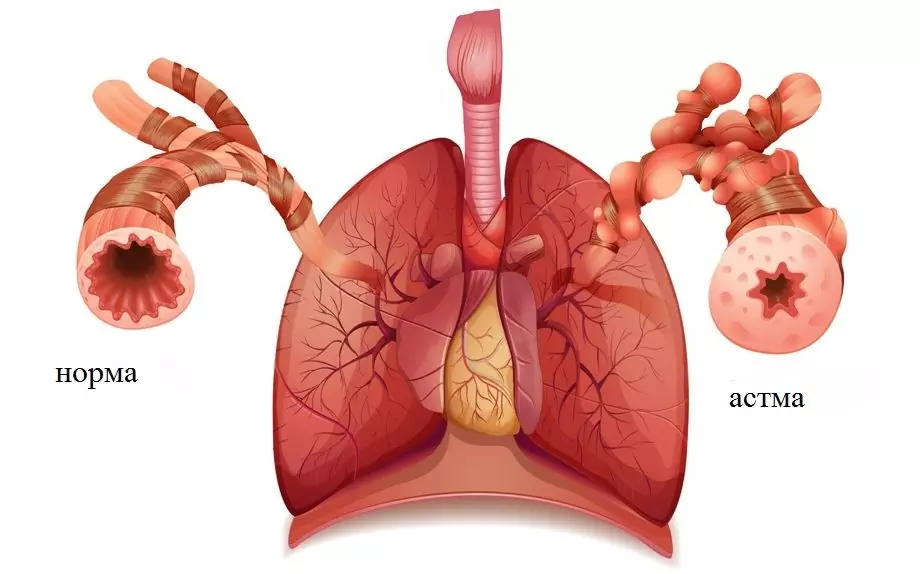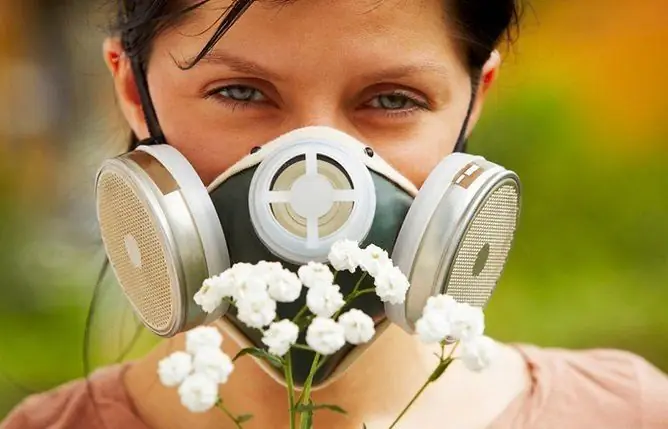- Author Rachel Wainwright [email protected].
- Public 2023-12-15 07:39.
- Last modified 2025-11-02 20:14.
Emergency care for bronchial asthma: first aid, signs of pathology, provoking factors
The content of the article:
- First aid for bronchial asthma
- How does bronchial asthma manifest?
- Causes and risk factors for the development of the disease
- Video
The correct provision of emergency care for bronchial asthma can significantly improve the prognosis, therefore, both the patient and his relatives need to know the algorithm for providing emergency care in the development of asthma.
Patients with asthma are advised not to leave the house without an inhaler with the prescribed medication, even if attacks are rare.

To quickly stop an attack of suffocation, you need to use a bronchodilator in the inhaler
First aid for bronchial asthma
Emergency care for an attack of bronchial asthma consists, first of all, in providing the patient with fresh air, in facilitating his breathing. To do this, it is necessary to free a person from tight clothing, or at least to loosen it, take a person out of a stuffy room or open a window. It is necessary to call an ambulance, and before the arrival of the team, help the patient to take a comfortable position. A posture with elbows or arms spread apart can relieve the patient's condition during an attack. For a mild attack, hot baths for the upper and lower extremities can help. If it is not possible to make a bath, you can rub the patient's hands.
If you have an inhaler with a drug that is intended for such cases, you need to help the patient to use it, for which you shake the bottle with the drug, make 1 or 2 injections while inhaling. For the most effective drug intake into the upper respiratory tract, the bottle should be kept upside down. The drug usually starts working after a few minutes. It is not recommended to repeat inhalation with a spray earlier than 20 minutes after the first injection, as this can cause the development of complications from the cardiovascular system. It is necessary to inform medical workers about all drugs that were used before their arrival.
With an attack of bronchial asthma, bronchodilators, cardiac glycosides, antispasmodics can be used, but they can only be used if they have been previously prescribed by a doctor.
If an attack of suffocation cannot be stopped by the ambulance team, the patient is admitted to a hospital. In the hospital, in addition to drug therapy, oxygen therapy, artificial ventilation of the lungs, and plasmapheresis can be performed. When the patient's condition stabilizes, physiotherapy is prescribed to facilitate the removal of accumulated mucus from the respiratory tract.
How does bronchial asthma manifest?
Asthma is characterized by a chronic course with alternating exacerbations and remission. With exacerbations, abundant sputum production begins, asthma attacks become more frequent. Patients may experience liquid transparent discharge from the nasal cavity, increased lacrimation, urticaria. Often, exacerbations of the disease have a pronounced seasonality. With non-allergic bronchial asthma, patients have attacks of severe coughing, which turns into attacks of suffocation. In the periods between attacks, the manifestations of the disease are minimal.
Harbingers appear 30-60 minutes before the onset of an attack, they consist in severe coughing, sneezing, sore throat and / or sore throat, profuse discharge from the nasal cavity, headache. With a disease of a non-allergic nature, the harbingers of an attack are cough, increasing weakness, fatigue, dizziness, anxiety, anxiety. Nocturnal attacks of suffocation are often preceded by a strong cough in the evening, sleep disturbances.
Immediately before the onset of an attack, patients experience difficulty speaking, noisy (wheezing) breathing, difficulty breathing, copious dry rales that can be heard even at a distance. In order to facilitate breathing, the patient takes a forced sitting position.
There are three degrees (stages) of bronchial asthma:
- Mild - the patient has shortness of breath while walking, the frequency of respiratory movements increases, but the auxiliary muscles do not take part in the breathing process, whistling wheezing is heard on exhalation. Heart rate less than 100 beats per minute.
- Average - shortness of breath can occur when talking, while eating, the breathing rate increases, the auxiliary muscles participate in breathing, and loud wheezing is heard. Heart rate is 100 to 120 beats per minute.
- Severe - characterized by shortness of breath at rest, restlessness, distant wheezing, heart rate exceeds 120 beats per minute.
With frequent contact of the patient with an allergen, a prolonged intractable attack, he may develop status asthmaticus, characterized by persistent bronchial obstruction. Status asthma poses a considerable danger to the patient's life, as death from suffocation is possible.
Bronchial asthma must be differentiated from chronic obstructive pulmonary disease, lung neoplasms, chronic non-specific lung diseases, obstructive bronchitis.
The prognosis depends on the timeliness of the start of treatment, the patient's compliance with all the necessary recommendations of the attending physician. If the patient receives the necessary care and adheres to medical prescriptions, the prognosis for life is favorable. In young patients, complete recovery is possible.
Causes and risk factors for the development of the disease
Depending on the cause, non-allergic and allergic asthma are distinguished. Allergens are most often: plant pollen, dust mites, animal hair, bird feathers, food for domestic fish. The reaction may not develop immediately after contact with the allergen, but after some time.
In recent years, there has been an increase in the incidence of bronchial asthma due to the high level of general allergy, especially among children.
In asthma of non-allergic etiology, spasm can be triggered by any irritation of the bronchi, for example, tobacco or any other smoke (for example, from burning leaves), vapors of household chemicals, strong odors, exhaust gases, taking certain medications. Intense physical exertion, inhaling too cold air, eating certain foods, emotional stress, stressful situations can also cause choking. At the initial stages of the disease, acute respiratory diseases can have a provoking effect. In a number of patients, pathology occurs due to the effect of not one, but several allergens.

Many factors can provoke an attack of suffocation.
In some cases, it is not possible to determine the exact cause of the disease even in the case of allergological tests. Diagnosis of occupational bronchial asthma can also be difficult due to the fact that a person may not pay enough attention to symptoms that develop at the workplace and disappear after the end of the working day.
Video
We offer for viewing a video on the topic of the article.

Anna Aksenova Medical journalist About the author
Education: 2004-2007 "First Kiev Medical College" specialty "Laboratory Diagnostics".
Found a mistake in the text? Select it and press Ctrl + Enter.






